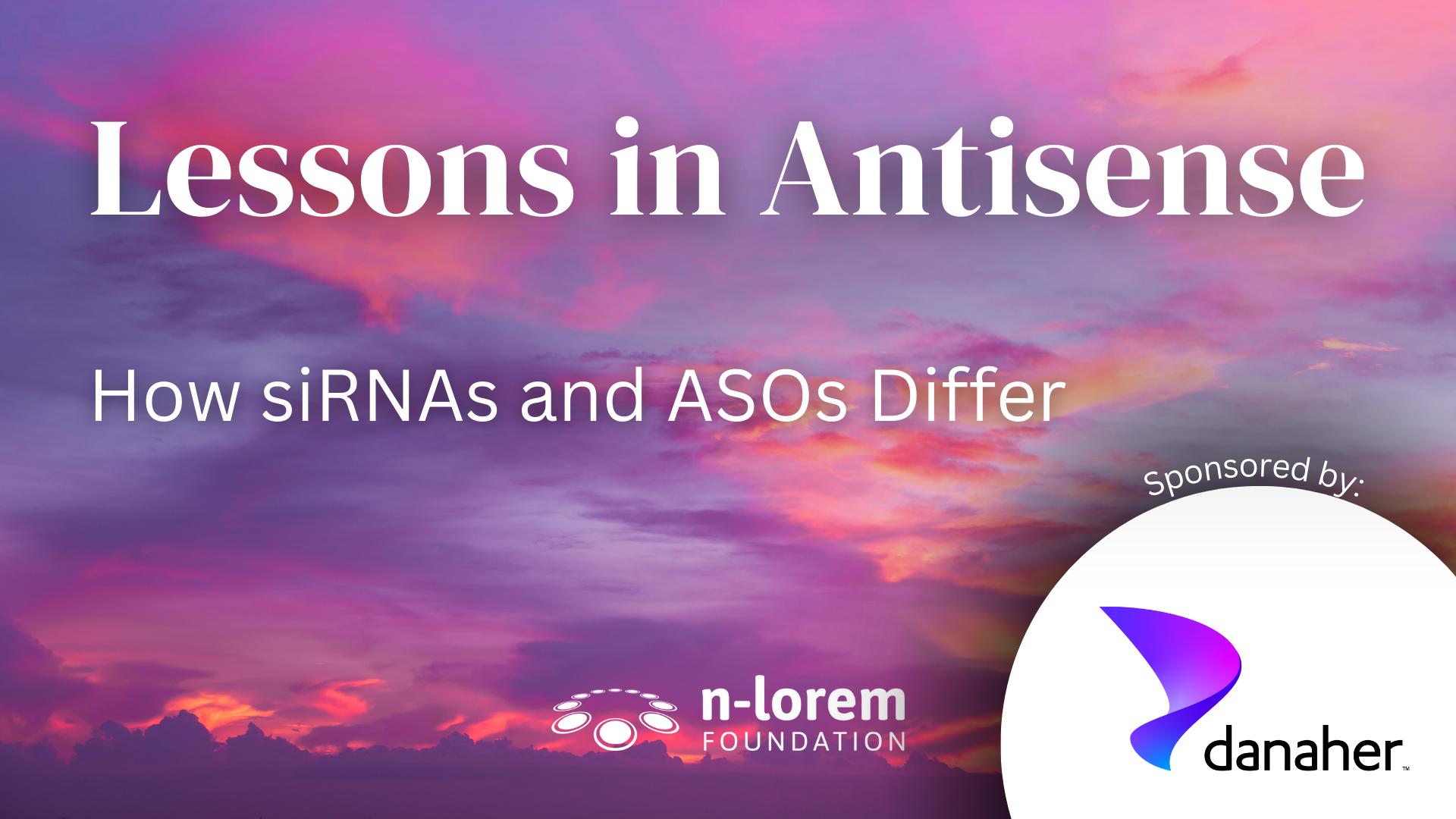Lessons in Antisense
Lesson 19 – How siRNAs and ASOs Differ
September 19, 2025 by Dr. Stan Crooke

Introduction
siRNAs and ASOs are both oligonucleotide therapeutics designed to hybridize to specific sequences in target RNAs. Phosphorothioate (PS) ASOs designed to serve as substrates for RNase H1 after forming a heteroduplex with the target RNA are designed to cause degradation of the target RNA. Similarly, siRNAs are designed to cause reduction of target RNAs after the antisense strand forms a duplex with the target RNA. The nuclease that cleaves the RNA is called Ago2 and has an RNase H1 motif. Hence, both siRNAs and PS ASOs are “antisense therapeutics” as the term antisense was defined as an approach to producing pharmacological effects by designing oligonucleotides antisense to target RNA sequences.
Physico-chemical properties
siRNAs differ from single strand PS ASOs. They are approximately double the molecular weight and this is important because their molecular weight is larger than 10 KD, which is an observed molecular weight limit on cell uptake. More importantly, because siRNAs are double stranded, they are much more hydrophilic than single strand PS ASOs. siRNAs behave as rather rigid rods while PS ASOs behave as highly flexible single strands that can adopt a partial helical structure. These differences in physicochemical properties lead directly to significant differences in pharmacokinetic properties and behaviors.
Medicinal chemistry
Because investment in antisense technology preceded that in siRNA, almost all oligonucleotide medicinal chemistry derived for ASO studies and that work was adapted for use in siRNAs. Since PS ASOs can be designed to result in multiple post RNA binding mechanisms of action and are single stranded, while siRNAs are designed to enter the RISC loading complex and create substrates for Ago2, the scope for medicinal chemistry is larger for ASOs than siRNAs. In fact, essentially every position in an ASO not involved in Watson-Crick H-bonding has been modified.
In contrast, siRNAs must have a phosphate on the sense strand to bind to the phosphate-binding pocket in Ago2 and limited 2’ modifications are allowed once again because of loading complex and Ago2 structural requirements. This has limited 2’ modifications to certain sites in siRNAs and to methoxy and fluoro. However, fluoro modifications have been associated with toxicities and, to a large extent, abandoned.
Further, only a limited number of sites in an siRNA tolerate PS modifications. In contrast, a range of conjugates appears to be tolerated by siRNAs and PS ASOs.
We demonstrated that by adding a stable phosphate (vinyl phosphate) to an ASO, a single stranded ASO could be loaded and use Ago2 to degrade target RNAs.
Molecular mechanisms of action
siRNAs are designed to enter the micro-RNA pathway via the Ago2 loading complex and activate Ago2. Ago2 is an RNase H-type nuclease that uses only the 7 nucleotide central seed region for selectivity. Since Ago2 in cells is fully loaded with micro-RNAs, siRNAs can dislodge micro-RNAs from Ago2. Consequently, both because of using the seven-nucleotide seed region only for specificity and dislodging micro-RNAs from Ago2, siRNAs can be somewhat promiscuous in their effects. Medicinal chemical modifications at specific sites have improved hybridization based off-target effects somewhat. siRNAs are generally believed to be active only in the cytoplasm, though there are reports of nuclear activities that we have been unable to reproduce.
PS ASOs designed to form substrates for RNase H1 are typically designed as gapmers that are 16-20 nucleotides long with 2’ modifications in the wings and 8-10 PS deoxynucleotides in the center of the ASO. In contrast to siRNAs, the entire ASO sequence is used to achieve target selectivity. RNase H1 is present in both the cytoplasm and nucleus and we have shown that H1 activating PS ASOs are active in both the cytoplasm and the nucleus. As it was argued that the longer residence of siRNAs on Ago2 might result in longer durations of action for siRNAs, we performed a careful study comparing PS ASOs and siRNAs and found that target reduction was roughly equal and, at equipotent doses, the duration of effect of H1 activating PS ASOs and siRNA was similar. Nevertheless, both in vivo and clinical studies have suggested that, in some cases, siRNAs produce longer durations of effect. The key problem in these studies is assuring that the duration of effect is measured at equipotent doses. All that said, I think the weight of evidence is that clinically, some siRNAs may result in longer durations of effect than some PS ASOs and that the mechanisms to explain this are not clearly worked out. Arguably more important of an advantage is that si RNAs primarily use a seed region of 7 nucleotides to define the target RNA to be cleaved, while PS ASOs use 16-20 nucleotides which, of course, means higher target selectivity. Another key advantage that derives from RNase H1 cleavage selectivity is that PS ASO can be designed to be allele-selective, i.e. to cause cleavage of only mutant RNA while sparing the RNA derived from the normal or wild type gene. This is vitally important for patients with heterozygous toxic gain of function mutations.
A key advantage of PS ASOs is that they can be designed to take advantage of a wide variety of mechanisms other than RNase H1. We have published that PS ASOs can be used to degrade RNAs via no-go decay and other non-H1 dependent mechanisms and alter poly-A site use, alter splicing, increase translation via uORFs and TIEs and of course we have used PS ASOs to serve as antimirs.
Protein binding
PS containing oligonucleotides bind to proteins. For PS ASOs, protein binding is reasonably well understood, and protein binding is essential for distributions, cellular entry and sub-cellular distribution, mechanisms of pharmacodynamics, cytotoxicity and innate immune activation, as well as complement activation. Much less is known about siRNA protein binding. Since most current therapeutic siRNA designs include a number of PS moieties, it seems likely that current therapeutic siRNAs bind to proteins and that protein binding may play a role in the effects of siRNAs. It would seem that assessing siRNA protein interactions would seem a worthwhile effort.
Pharmacokinetics
The differences in physico-chemical properties between siRNAs and PS ASOs translate directly into fundamental differences in pharmacokinetic properties. After systemic delivery, unmodified siRNAs are rapidly cleared in urine and do not distribute to peripheral organs to any significant degree. This led to the use of various liposomal type formulations, including what were called LNPs. Though this approach resulted in delivery to the liver sufficient for therapeutic activity, it was associated with the need to dose by IV infusions and significant pro-inflammatory effects that required pretreatment with steroids. Thus, when GalNAc conjugation was introduced, the future of siRNA therapies was dramatically enhanced in that modified (typically with PS moieties and 2’-methoxys at various sites in the siRNAs) can now be given subcutaneously and demonstrate potent activities in the liver, specifically hepatocytes. Current siRNA research appears to be almost entirely focused on identifying other ligands to conjugate that can to used to deliver siRNAs to organs other than the liver and to enhance CNS distribution after intrathecal administration.
In contrast, PS ASOs distribute fairly broadly after systemic administrations with liver, kidney, bone marrow and fat cells accumulating most ASO at low doses. As doses are raised, the primary tissues saturate, and PS ASOs accumulate in other organs. PS ASOs also distribute broadly throughout the CNS. GalNAc conjugation of PS ASOs does NOT alter bulk distribution, but productive delivery to hepatocytes is enhanced resulting in a 20-30 fold increase in potency for hepatocyte targets. In contrast, GalNAc conjugation of siRNAs greatly increases bulk delivery to the liver. GLP1 analogs have also been reported to dramatically increase PS ASO concentrations in beta cells of the pancreas, and recent work has suggested that both antibodies and cyclic peptides to transferrin can increase PS ASO accumulation in skeletal muscle and the CNS after systemic delivery.
Conclusions
Both siRNAs and PS ASOs are attractive therapeutic agents. From a pharmacological perspective, the mechanisms of absorption, distribution, tissue clearance, cell uptake, mechanisms of action, mechanisms of cytotoxicity and innate immune activation are better understood for PS ASOs. PS ASOs are mechanistically much more versatile than siRNA and have broader therapeutic utility with siRNAs being limited at present to activity in hepatocytes. PS ASO technology continues to evolve across a broad front while siRNA research seems almost entirely focused on delivery to non-liver tissues. PS ASOs are also farther along in development for very prevalent diseases, such as cardio-metabolic and renal diseases and broader CNS diseases, such as Parkinson’s disease.

We cannot do
this alone
Together we are changing the world—
one patient at a time
We hope that you join us on this journey to discover, develop and provide individualized antisense medicines for free for life for nano-rare patients. The ultimate personalized medicine approach – for free, for life.
Follow us on social for updates on our latest efforts


